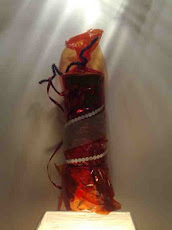



It is accepted that between 50% to 70% of the heat emitted by a household radiator is eventually lost into the fabric of the building, mainly behind the radiator and into the wall behind. A reflector panel fits behind the radiator and reduces the wasted heat by insulating the wall and so the heat that is saved either heats the air in the room, warming it faster, or is retained in the system so the boiler is not using as much fuel.
It is very easy to make your own Radiator Reflector. All you need is a tape measure to work out the size of panel, scissors, stapler some adhesive tape, a thin strip of wood, a sheet of cardboard and one of those silver heat reflecting panels you can buy to put in the windscreen/windshield of your car to keep it cool in the sunlight.
Cut the cardbord to size, place it on the reflector, cut that to suit and staple it to the cardboard. Attach a thin strip of wood to the top, I used Duck Tape as it is temperature resistant and drop the completed unit onto the supports behind the radiator!

9 comments:
I am very grateful for your brillliant idea to simply use car windscreen reflectors--I ggogled make radiator panels as I have just seen an ad for buyin Heatkeeper panels. The windscreen reflectors are normally available at my local £1 shop.
Thanks for a great tip.
I am more than glad you like the idea, and the reflector you see was from my local £1 shop!
Thank for for the great idea and the easy to use instructions (with pictures).
Thank you for your kind comments Noel, I point I missed is that it is easy to remove the item for cleaning... but then, I'm a bloke...
Great idea but I was just wondering if ordinary kichen aluminium foil would do the job just as well...........?
Not quite as well as ordinary foil lacks the foam backing that also acts as an insulator.
Any chance at a follow-up? The important question is: did it end up lower your heating bill?
Hi Anonymous,
I was doing several jobs at the same time that were involved in reducing heating needs so could not get an individual saving.
I used a somewhat crude but seemingly effective method of measuring the wall temperature behind the foil, before and after fitting, in order to check the temperature of the wall and to see if there was a difference in temperature and so a reduction in heat absorption. My thoughts were that the lower the wall temperature the more the heat from the radiator went into the room.
There always was a marked difference, and these differences depended on wall construction.
Post a Comment